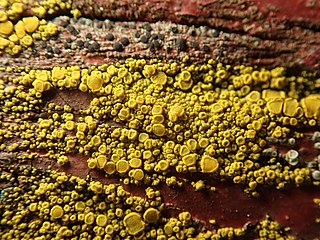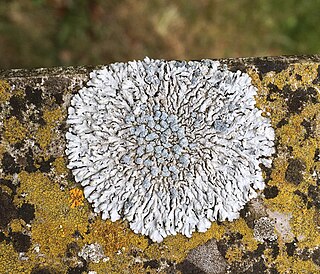
The Verrucariaceae are a family of mostly lichenised fungi in the order Verrucariales. The lichen-forming species have a wide variety of thallus forms, and include crustose (crust-like), foliose (bushy), and squamulose (scaly) representatives. There are several dozen lichenicolous (lichen-dwelling) examples in the family, and some genera that contain solely lichenicolous members. An unusually wide variety of photobiont partners have been recorded, mostly green algae, but also brown algae and yellow-green algae. The family, circumscribed nearly two centuries ago, now includes 56 genera and over one thousand species. Most diversity occurring in the temperate climates of the Northern Hemisphere. Rocks and soil are the most common substrates for the Verrucariaceae, with growth on wood and bark less common. Some semi-aquatic lichens occur in this family, including about two dozen species of marine lichens.

Acarospora is a genus of lichenized fungi in the family Acarosporaceae. Most species in the genus are crustose lichens that grow on rocks in open and arid places all over the world. They may look like a cobblestone road or cracked up old paint, and are commonly called cobblestone lichens or cracked lichens,. They usually grow on rock, but some grow on soil (terricolous) or on other lichens. Some species in the genus are fungi that live as parasites on other lichens. Acarospora is a widely distributed genus, with about 128 species according to a 2008 estimate.

Parmotrema is a genus of lichen belonging to the family Parmeliaceae. It is a large genus, containing an estimated 300 species, with a centre of diversity in subtropical regions of South America and the Pacific Islands.

Candelariella is a genus of bright yellow, ocher, or greenish yellow crustose or squamulose lichens in the family Candelariaceae. Members of the genus are commonly called eggyolk lichens, goldspeck lichens, or yolk lichens. The genus was circumscribed in 1894 by Swiss lichenologist Johannes Müller Argoviensis, with Candelariella vitellina assigned as the type species.

The Caliciaceae are a family of mostly lichen-forming fungi belonging to the class Lecanoromycetes in the division Ascomycota. Although the family has had its classification changed several times throughout its taxonomic history, the use of modern molecular phylogenetic methods have helped to establish its current placement in the order Caliciales. Caliciaceae contains 36 genera and about 600 species. The largest genus is Buellia, with around 300 species; there are more than a dozen genera that contain only a single species.

Pilophorus acicularis, commonly known as the nail lichen or the devil's matchstick lichen, is a species of matchstick lichen in the family Cladoniaceae.
Caloplaca durietzii, or Durietz's orange lichen, a smooth surfaced yellowish orange crustose areolate lichen with elongated lobes that grows on wood or bark in southwestern North America. It is commonly seen growing on old junipers in Joshua Tree National Monument in the Mojave Desert. It is in the Caloplaca fungus genus of the Teloschistaceae family.

Physcia caesia, known colloquially as blue-gray rosette lichen and powder-back lichen, is a species of foliose lichenized fungus. First described by Georg Franz Hoffmann in 1784, it is common across much of Europe, North America and New Zealand, and more patchily distributed in South America, Asia, Australia and Antarctica. There are 2 subspecies: P. c. caesia and P. c. ventosa, as well as a number of distinct forms and varieties. Molecular studies suggest that the species as currently defined may be polyphyletic. It is typically pale gray shading to darker gray in the center, and grows in a small rosette, usually some 2–3 cm (0.79–1.18 in) across at maturity. It only rarely has apothecia, instead reproducing most often vegetatively via soredia, which are piled in round blue-gray mounds across the thallus's upper surface. It grows most often on rock—principally calcareous, but also basaltic and siliceous—and also occurs on bone, bark and soil. It is nitrophilic and is particularly common on substrates where birds perch.

Pyxine sorediata, commonly known as mustard lichen, is a widely distributed species of foliose lichen in the family Caliciaceae. It has a subtropical to warm temperate distribution, and grows on bark, rocks, and moss as substrates. Pyxine sorediata has been reported from regions of North America, Europe, Africa, Asia, and Australasia.

Punctelia hypoleucites, commonly known as the southwestern speckled shield lichen, is a species of foliose (leafy) lichen in the family Parmeliaceae. First formally described by Finnish botanist William Nylander as a species of Parmelia, it was transferred to the genus Punctelia in 1982. The lichen is found in Africa, North America, and South America, where it grows on the bark of both hardwood and coniferous trees. Its greenish-grey thallus is covered with tiny white pseudocyphellae – minute holes in the thallus surface that facilitate gas exchange. Some macroscopic features that help distinguish this species from other related members of the genus include the presence and the structure of the apothecia, the absence of asexual surface propagules, and the light brown color of the thallus undersurface. Chemically, the presence of lecanoric acid in the medulla and atranorin in the cortex help distinguish it from lookalikes.

Punctelia perreticulata is a widely distributed species of foliose lichen in the family Parmeliaceae. It occurs in Mediterranean Europe and Russia, North America, South America, Australia, and New Zealand, where it grows on rocks, bark, or wood. Its main distinguishing features are its thallus surface, marked with many shallow depressions, grooves, or pits, and sorediate pseudocyphellae. The lower side of the thallus is ivory to tan towards the centre and the major secondary metabolite in the medulla is lecanoric acid. A lookalike species with which it has been historically confused is Punctelia subrudecta; this lichen can be distinguished from Punctelia perreticulata by the texture of the thallus surface, or, more reliably, by the length of its conidia.

Hydropunctaria is a genus of saxicolous (rock-dwelling), crustose lichens in the family Verrucariaceae. The genus includes both aquatic and amphibious species, with members that colonise either marine or freshwater habitats. The type species, Hydropunctaria maura, was formerly classified in the large genus Verrucaria. It is a widely distributed species common to littoral zones. Including the type species, five Hydropunctaria lichens are considered marine species: H. adriatica, H. amphibia, H. aractina, H. orae, and H. oceanica.

Punctelia graminicola is a species of foliose (leafy) lichen in the family Parmeliaceae. It grows on rocks, and, less frequently, on bark in North America, South America, and East Africa. It has a blue-grey thallus measuring up to about 15 cm (6 in), covered with tiny pores called pseudocyphellae. Sometimes the lichen forms small lobes that project out from the surface. Fruiting bodies are uncommon in this species; if present, they resemble small cups with a brown internal disc measuring 3–10 mm (0.1–0.4 in) in diameter. A lookalike species, Punctelia hypoleucites, is not readily distinguishable from Punctelia graminicola by appearance or habitat alone; these species can only be reliably differentiated by examining the length of their conidia.

Solenopsora is a genus of lichen-forming fungi in the family Catillariaceae. It has 15 species, with a mostly Northern Hemisphere distribution.

Sporastatia is a genus of crustose lichens in the family Sporastatiaceae. It has four species. Sporastatia lichens are long-lived species that grow on siliceous or weakly calcareous rocks in arctic and alpine locales.
Apatoplaca is a fungal genus in the family Teloschistaceae. It is monotypic, containing a single species, the rare crustose lichen Apatoplaca oblongula, found in the United States.
Phacopsis australis is a species of lichenicolous (lichen-dwelling) fungus in the family Parmeliaceae. It is found in a few locations in South Africa, where it grows on the thalli of several species of the leafy lichen genus Xanthoparmelia. Unlike other members of genus Phacopsis, the fungus does not induce the formation of galls in its host.
Phacopsis lethariellae is a species of lichenicolous (lichen-dwelling) fungus in the family Parmeliaceae. It was formally described as a new species in 1995 by Josef Hafellner and Gerhard Rambold. The type specimen was collected by the first author from La Fortaleza at an altitude of 1,180 m (3,870 ft), where it was found growing on the thallus of the lichen Lethariella intricata. It causes formations of galls, which also creates a torsion on the thallus. It has dark brown to black apothecia that are typically 0.3–0.5 mm in diameter, with a convex disc. Its ascospores are ellipsoid to ovoid, measuring 11–13 by 6–7 μm. The fungus, known to occur only in the Canary Islands, is named after the genus of its host.
Lecania sessilisoraliata is a species of saxicolous (rock-dwelling), crustose lichen in the family Ramalinaceae. It is found on rock outcrops in the mountainous Burdur region of Turkey.
Phacopsis thallicola is a species of lichenicolous (lichen-dwelling) fungus in the family Parmeliaceae. It was first formally described as a new species in 1852 by Italian botanist Abramo Bartolommeo Massalongo, as Lecidea thallicola. The type specimen, collected from the province of Treviso in Italy, was growing on the foliose lichen Parmelia caperata. Dagmar Triebel and Gerhard Walter Rambold transferred the taxon to the genus Phacopsis in 1988. The known generic hosts of Phacopsis thallicola are all in the Parmeliaceae: Parmotrema, Cetrelia, Flavopunctelia, and Hypotrachyna.















